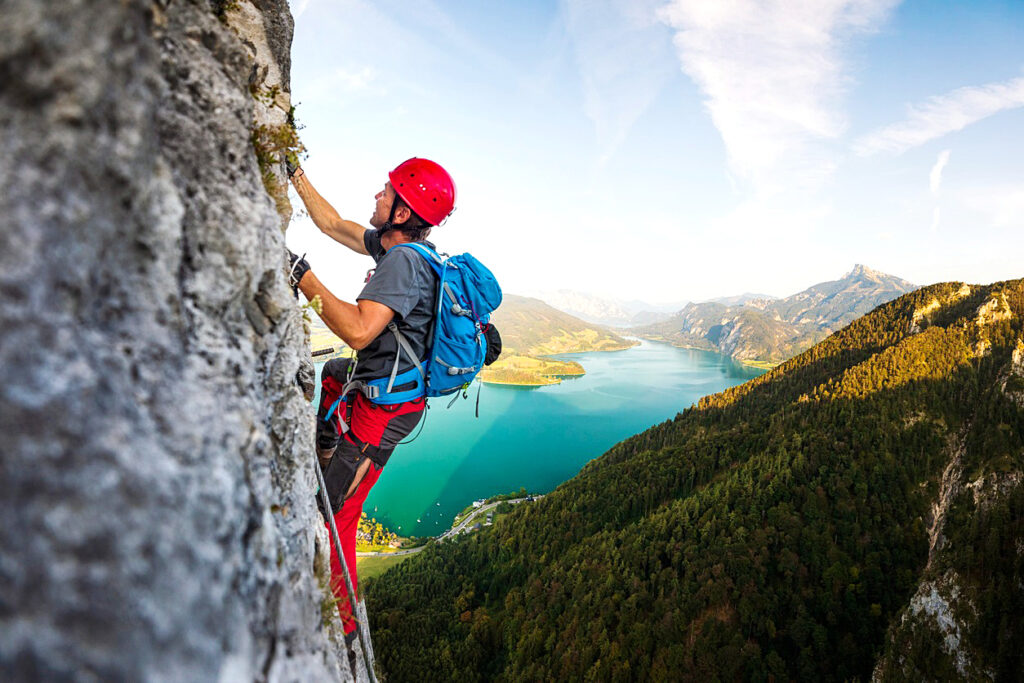Mountain climbing is a thrilling and challenging outdoor activity that attracts
enthusiasts from around the globe. While it offers breathtaking views and a sense
of accomplishment, it also poses certain risks, including the potential for sports
injuries. Sports injuries, in the context of mountain climbing, differ from other
types of injuries due to the unique demands and conditions of this adventurous
pursuit. In this article, we will explore what sports injuries are, how they differ
from other injuries, examine their occurrence in mountain climbing, and discuss
preventive measures and treatment strategies.

What is a Sports Injury?
A sports injury is any harm that occurs during athletic activities or exercise. These
injuries can affect various parts of the body, including muscles, bones, ligaments,
and tendons. Unlike injuries that result from accidents or falls in everyday life,
sports injuries are typically associated with physical activities and are often
preventable through proper training and precautions.
Distinguishing sports injuries from others
The primary distinction between sports injuries and other types of injuries lies in
their connection to physical activity. Sports injuries are specific to activities that
involve physical exertion, competition, and skill. These injuries can be acute,
resulting from sudden impacts or movements, or chronic, developing over time
due to repetitive stress on specific body parts.
In mountain climbing, sports injuries are unique because they often involve a
combination of factors, including the challenging terrain, environmental conditions,
and the strenuous nature of the activity. Climbers may experience
injuries to their extremities, such as sprained ankles or fractures, as well as
overuse injuries like tendonitis from repetitive motions.
Causes of Sports Injuries in Mountain Climbing:
Mountain climbing presents a multitude of challenges that can contribute to the
occurrence of sports injuries. Uneven terrain, extreme weather conditions, and
the physical demands of ascending and descending can all play a role. Common
causes of injuries in mountain climbing include:
- Falls: Climbers may slip or lose their footing, leading to falls that can result in
fractures, sprains, or dislocations. - Overexertion: The strenuous nature of climbing, especially at high altitudes,
can lead to overexertion, causing fatigue and increasing the risk of injuries. - Equipment Failure: Malfunctioning or inadequate gear can contribute to
accidents and injuries during a climb. - Environmental Factors: Harsh weather conditions, such as strong winds,
freezing temperatures, or unexpected storms, can pose additional challenges and
increase the risk of injuries.
Common Injuries while mountain climbing
Climbing is known for its bumps and bruises, but like with any sport, there is a risk
of damage from extreme physical exertion. Your condition will only become
worse if you ignore an injury and try to push through the discomfort. Fortunately,
with the right training methods and positive behaviors, climbing injuries can be
minimized.
- Finger pulleys Injury:
One of the most frequent injuries sustained during climbing are finger pulley
tears, which are quite specific to the activity.
A finger pulley tear is caused by applying too much weight on a finger tendon,
usually as a result of crimping or a rapid movement.
These injuries frequently occur when you use one or two fingers to open a pocket
or when you use the tips of your fingers to grab onto something small.
You’ll frequently experience a real pop. There is instant pain, and swelling soon
follows.
Treatment & Prevention: The first line of treatment for a finger pulley injury is to
apply ice and take an anti-inflammatory.
When resuming climbing, stay off of large jugs and other holds that impose direct
pressure on the injured finger or fingers.
While climbing, taping these fingers is effective to aid in healing.
- Rotator Cuff Injuries:
Another dangerous shoulder injury is a rotator cuff tear. Because we spend a lot
of time with our arms extended above our shoulders during climbing, it’s a unique
sport that strains the tendons.
A slight tear is indicated by pain and soreness in your shoulders and upper arms
as you raise your arms above your head. Additionally, you might feel a little weak
and numb.
Treatment & Prevention: For mild tears, the recommended therapies are rest
and ice. It’s crucial to see a doctor as soon as possible after any injury because
more severe tears can need medical attention.
In order to make sure that your shoulders regain their full range of motion during
the healing period, physical therapy may also be beneficial. - Shoulder Subluxation :
Shoulder subluxation, or partial dislocation of the shoulder, is particularly
common in climbers who boulder or do big, overhead movements.
It occurs when the ball joint of the shoulder is brought too far forward. A strong
pain in the back of your shoulder will alert you to the need to stop climbing right
once because carrying on could cause a complete dislocation.
Treatment & Prevention: Medical attention and physical treatment are necessary for recovery.
You can regain your full strength and range of motion with the use of stretching and
conditioning exercises.
- Tendonitis:
Tendonitis is often defined as tendon inflammation or discomfort.
The most typical symptom is a dull, agonizing pain that frequently has swelling in
addition to it. Tendinitis in climbers typically affects the forearms, elbows, and
shoulders.
Additional terms for tendinitis:
Tennis Elbow, Jumper’s Knee, Pitcher’s shoulder
Climbing can be connected to tendinitis in any area of the body, even though
these names relate to other sports that are linked to the illness. Rather than being
the direct outcome of an injury, tendinitis is more of a chronic ailment that gets
worse with time. Repetitive actions leading to persistent tugging on the same
muscles cause it.
Treatment & Prevention: In order to prevent tendonitis from becoming a tendon
rupture, which is a far more dangerous injury that could require surgery, one
should take rest from climbing, apply Ice, seeking medical care & physiotherapy. - Trigger finger:
The fingers may freeze up when you bend them, a condition known as trigger
finger. There may be some stiffness and a popping or clicking sound.
This is because a cyst has grown inside the flexor tendons in your finger, which
limits your grip strength and can be annoying (though not unpleasant) when
climbing.
Treatment & Prevention: The majority of symptoms begin mildly and get worse
with time. Physical therapy, anti-inflammatory drugs, and rest are the only
effective treatments. Changing up your training and climbing style is the greatest
approach to avoid trigger finger syndrome.
- Cracked feet:
Cracked feet are most often seen at the heel point due to dryness and damage
from heel hooking or crack climbing. This makes it quite unpleasant to put on
your climbing shoes the following day. Even if it’s not fatal, it may definitely limit
your style, so it’s best to be proactive.
Prevention & Treatment: Before and after you climb, use a daily lotion to keep
your feet flexible and silky. If you have a cracked heel or sole, change up your
climbing technique and apply a healing salve. - Abrasions:
Although abrasions and bruises are inevitable during climbing, it may be
necessary to take precautions to lessen the likelihood or severity of these injuries
if cracks leave your hands completely destroyed and covered in what climbers
lovingly refer to as “gobies.” Scraping your skin on a rock causes abrasions.
One particularly well-known source of abrasions is sharp rock. These injuries are
not life-threatening, but they do require time to recover, therefore taking
preventative steps is highly recommended.
Treatment & Prevention: Tape gloves are your best line of defense when it comes
to your hands. For serious climbers, a lot of climbing clothing manufacturers also
offer climbing-specific gloves.

General Prevention of Sports Injuries in Mountain Climbing
Preventing sports injuries in mountain climbing involves a combination of proper
preparation, training, and adherence to safety protocols. Climbers can take
several measures to minimize the risk of injuries:
- Training: Adequate physical conditioning, including strength training and
cardiovascular exercises, helps prepare the body for the physical demands of
climbing. - Skill Development: Learning and honing climbing techniques can enhance a
climber’s ability to navigate challenging terrain safely. - Gear Inspection: Regularly inspecting and maintaining climbing equipment
ensures its reliability and reduces the risk of equipment-related accidents. - Weather Awareness: Staying informed about weather conditions and being
prepared for unexpected changes can help climbers avoid adverse situations.
General Treatment Strategies
Despite preventive measures, injuries can still occur in mountain climbing. Prompt
and appropriate treatment is crucial for a successful recovery. Common
treatment strategies include:
- First Aid: Immediate first aid, including rest, ice, compression, and elevation
(RICE), can help manage acute injuries like sprains and strains. - Medical Assistance: Seeking professional medical assistance is essential for
more severe injuries, such as fractures or dislocations. - Rehabilitation: Rehabilitation programs, including physical therapy, help
climbers regain strength, flexibility, and mobility after an injury. - Rest and Recovery: Allowing adequate time for rest and recovery is crucial for
the healing process, preventing the risk of recurring injuries.

Conclusion
Mountain climbing, with its inherent challenges and risks, requires careful
consideration of sports injuries and their prevention. Understanding the unique
nature of these injuries, their causes, and the measures to prevent and treat them
is essential for climbers to enjoy this exhilarating activity safely. By prioritizing
training, equipment safety, and environmental awareness, climbers can mitigate
the risks associated with mountain climbing and continue to pursue their passion
with confidence.




